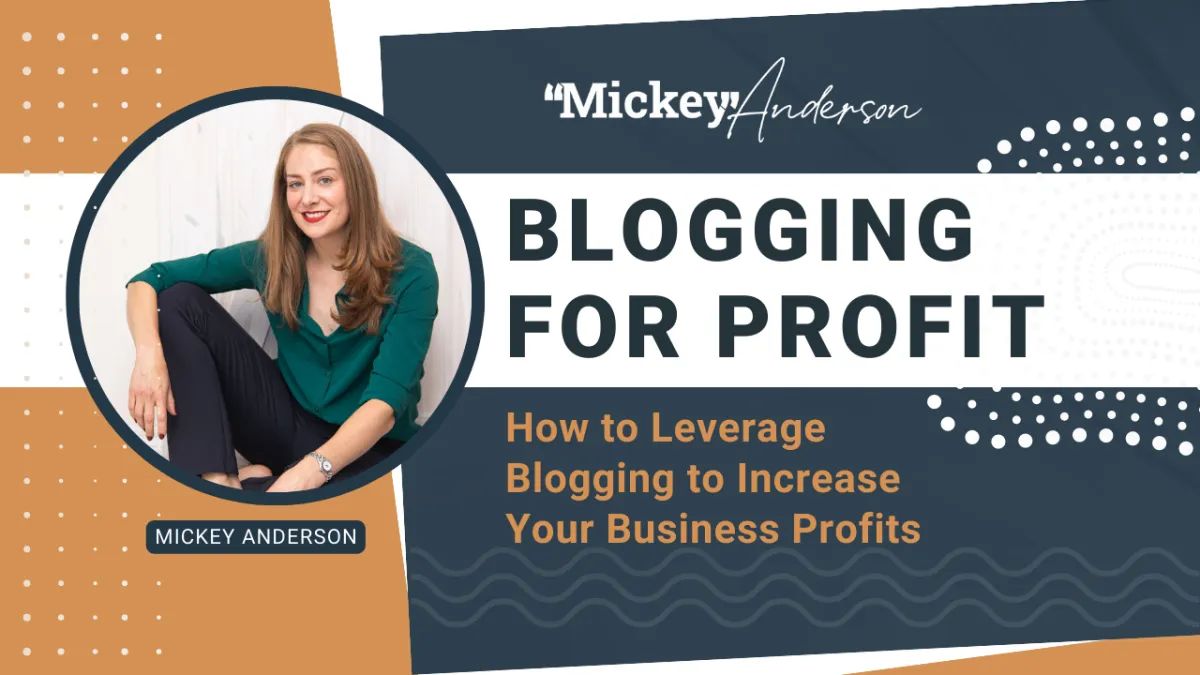

Welcome to your one-stop hub for all things precision marketing
Ignite your growth with top-notch resources in SEO content, social media, and email marketing, specially designed for accounting, tax and bookkeeping firms.

Blogging for Business: Enhance Presence and Increase Profits
Picture this. Blogging for Business is on your to-do list. You know how to write–you're a savvy entrepreneur and author eager to grow your online presence.
You know the benefits of consistent blogging, like ranking on search engines. But where do you start? You stare at the blank page wondering why writing a blog feels almost harder than writing your book.
Welcome to the world of business blogging! Yes, you can share company news, but the power of blogging is that it can amplify your business growth! This post will demonstrate how blogging for business can maximize your brand's online visibility, grow your email list, and increase revenue by creating compelling content, strategically distributing it, and optimizing for scale.
We'll walk through how to craft high-quality content that resonates with your audience, drive traffic through strategic distribution, and scale your efforts by repurposing content effectively. So buckle up and get ready to transform your business blog into a powerful marketing tool!
***Please note that our articles may contain affiliate links. If you purchase something through one of these links, we may receive a commission. We only share affiliate links to products and services we use, love and trust and do not let our affiliate status impact the content we share***
Table Of Contents:
The Power of Blogging for Business
Blogging is a powerful tool that helps businesses communicate value to their ideal customers, close more sales, and increase the overall worth of their digital real estate. It allows you to create content that connects with your audience, overcomes objections before they happen, introduces your products or services, and ultimately leads them to a buying decision. But that's only the beginning! Over the past 10 years, I've helped hundreds of clients leverage their blogs to drive revenue with content marketing, and blogging is the nucleus of successful content efforts.
Overcoming Objections Through Valuable Content
The key here is crafting high-quality blog posts addressing common concerns and questions potential clients may have about your offerings. This is considered bottom-of-funnel content (BOFU Content) that helps a prospective client get closer to making a purchasing decision. By answering objections and questions before reaching the point of sale, you'll develop trust with the prospect and streamline the sales process.

This proactive approach also positions you as an expert in your field - making it easier for prospects to choose you over competitors. A simple process we follow is reviewing the website content of competitors to identify what questions and objections they have not addressed with their content. This process can provide fresh topic ideas along with perspective around why prospects may choose your brand over others.
Using Blogs as an Introduction to Products/Services
A well-written blog post can serve as the perfect introduction to what you offer without being overly promotional or pushy. Most businesses wait until it's time to sell to build offer awareness, but the sooner your ideal prospect knows about your offer, the easier the decision may be in the future. Build offer awareness by creating blog content around your offers, describing their value and the problems they solve, and including case studies that build trust.
Integrating offer mentions naturally within relevant articles, combined with strong calls-to-action (CTAs), will guide prospects toward taking the next step in becoming loyal customers–they will have fewer questions and concerns when it's time to buy!
Why Your Website Matters More Than Social Media
It's no secret that Facebook and Instagram are popular marketing channels, but don't overlook the significance of your website. Your website is your online property, while social media profiles are more like rented spaces with limited control over content visibility and distribution. A blog on your website ensures you retain ownership and control over distribution and visibility, free from ever-changing algorithms.
Blogging allows you to take charge of how your content reaches potential customers by creating an audience-centric experience tailored specifically for them. You can then strategically share valuable information from your website content through mediums like email newsletters or guest posts on credible websites within your niche.
Did you know email marketing has higher conversion rates than social media? It's a powerful tool when used alongside blogging efforts and an underleveraged way to drive website traffic.
Crafting High-Quality Content That Connects With Your Audience
Remember that you aren't writing a blog post about something; you're writing a blog post for someone. This concept is taught by AJ Harper in Write A Must Read and applies directly to content creation. Creating content that resonates with your target audience starts by using keywords effectively in your blog posts. This ensures you're addressing their needs and interests while boosting search engine visibility.
Pro tip: Use tools like Ahrefs Keywords Explorer or Moz Keyword Explorer to find relevant terms for your niche.
Incorporating Personal Stories into Writing
We process, understand and remember information better when it's presented in a story. Anecdotes and personal experiences can make a huge difference in connecting with readers on an emotional level and help your content be understood and remembered. Stories can be from you and your team or from existing customers.
Adding your individual viewpoint to the content you present makes it more noteworthy for your crowd while likewise giving a feeling of authenticity and trustworthiness.
Clear Headings and Subheadings: A Must-Have.
A well-structured post is easier to read, understand, and digest - which means better engagement from visitors. Most people are reading blog articles on their phones, skimming and swiping through. Headings and subheadings help readers filter through content to identify what is relevant and whether they should continue reading.
Bonus points if you use catchy headings that grab attention right away (think "5 Mind-Blowing Tips..." instead of just "Tips..."). Just be sure to back up your promise and deliver–there's no greater content crime than wasting a prospect's time with content that doesn't live up to the hype.
Visuals/Images: The Cherry on Top
Including eye-catching visuals not only breaks up large chunks of text but also helps illustrate key concepts or ideas within the content itself. Think about it; images and visuals help us understand, process and retain information better. A rule at our content agency is to never choose an image or visual just for the sake of one–it must amplify, clarify or support the content.
Consider using Canva or Unsplash for high-quality, royalty-free images. Not into stock images? We love using screenshots!
SEO Best Practices: Your Secret Weapon
Last but not least, always keep SEO best practices in mind when crafting your content. Think about SEO in this way: Value to the reader always comes first, then optimize it for search engines second. Stuffing an article with keywords and useless text to 'boost search rankings' isn't going to serve your business. Start your blogging strategy with keyword research and look for topics related to your offers.
Don't forget to include the basics like optimized meta tags, incorporating internal and external links, and ensuring readability is top-notch. Internal links help your reader navigate through your site, and external links show search engines that your site is an authority that other high-authority sites trust. Our favourite SEO Content Editor is SurferSEO, where you can easily optimize your existing content without detracting from the value.

Action step: Check out this comprehensive guide on on-page SEO by Backlinko.
Driving Traffic Through Strategic Content Distribution
Mark DeGrasse, President of DigitalMarketer, teaches the concept of the Content Nucleus in their Digital Marketer Social Media Mastery Certification. He explains that a piece of content can act as a content nucleus by being repurposed and distributed across various channels in many ways. Your blog posts can become the core of your marketing efforts and be transformed into value-driven, engaging emails and social media posts that attract ideal prospects and drive website traffic.
Promote your blog posts to your relevant audience by leveraging strategic content distribution on email and social media. Distribute them strategically across various online platforms and in a variety of ways to maximize the content reach and make your long-form content go further.
Email Marketing: Share new content with subscribers who have already shown interest in your business. We love splitting blog posts into multiple emails, including teasers, key takeaways, and snippets.
Social Media Promotion: Create eye-catching graphics and captions for Facebook, Instagram, LinkedIn, and Twitter to promote your latest blog post. You can pull quotes from your post, share statistics and data, and share tips or hacks.
Influencer Outreach: Reach out to industry experts who might be interested in sharing or linking back to your content. The more inbound links you have from high-authority websites, the higher your site will rank in search engines. Affiliate marketing can be a great way to incentivize influencers to create content for your brand.
Guest Blogging: Write guest articles on other websites within your industry that link back to relevant content on yours. Again, ensure your guest blogs include a link to your landing pages to maximize your SEO efforts.
Note: Prioritize quality over quantity when distributing content; focus on reaching the most engaged audiences rather than spamming everyone you can find.
Leveraging Social Media Platforms Effectively
Different social media platforms require different strategies for promoting blog posts effectively. It's important that you customize your content to each platform–skipping this step can cost you impressions and clicks.
Facebook: Create a captivating headline and include an engaging image or video along with a brief description of the post's main points. Remember that Facebook Posts with images and videos are usually engaged more.
Instagram: Create visually appealing images or short videos highlighting key takeaways from the post. Use appropriate hashtags and consider using Instagram Stories to drive traffic. You can even use your blog post as a script and go live on Instagram to increase your reach.
LinkedIn: Share your post with a professional tone, focusing on how it provides value to the reader. Engage in relevant LinkedIn groups where your target audience might be present. LinkedIn heavily favours engagement over links, so avoid adding a link to your article in your post and add it to the comments instead.
Twitter: Craft multiple tweets promoting the blog post, each highlighting different aspects or quotes from the content. Use popular hashtags related to your industry for increased visibility. Blog posts can turn into amazing Twitter threads!
To maximize your results, monitor engagement metrics and adjust distribution strategies accordingly. Don't forget to repost your best-performing social media content every quarter!
Repurposing and Scaling Your Content Efforts: Work Smarter, Not Harder
You can unlock the true potential of your blog content by repurposing and scaling it effectively. Let's explore how to maximize your content efforts without sacrificing quality or consistency.
Turning Long-Form Blogs into Short-Form Content
Create shorter, digestible pieces from your long-form articles for use in emails or social media posts. Headings and sub-headings create breaks in the content to pull shorter content from. You can transform a single sub-heading section in an article into multiple formats like infographics, videos, podcasts, or even tweet threads.

By repurposing your long-form content into short-form content, you'll reach a wider audience while reinforcing key messages across various platforms. You'll also benefit from a consistent voice and message across your marketing platforms.
Establishing a Consistent Posting Schedule
Aim for regularity in posting blog content - once per week is an ideal starting point, then work up to twice per week, etc. We love using editorial calendars to plan topics ahead of time and maintain momentum throughout the year. We also recommend blocking off time in your schedule to batch-create content whenever possible. It always feels better when you've got a few weeks' buffer in case your content team (or you) gets behind.
One of the sneaky benefits of consistent blogging is that your audience will appreciate knowing when to expect fresh content from you and trust your brand as an authority in your industry.
Quality Over Quantity: The Golden Rule
Rather than producing a lot of sub-par material rapidly, concentrate on delivering meaningful content that appeals to viewers. AI is a huge hot topic in the content world, and although it can speed up the content creation process, thoughtful human optimization is always required.
Remember, engagement trumps volume every time.
Embrace Collaboration: Team Up For Success
Consider partnering with other industry experts or influencers to co-create content that showcases diverse perspectives and expertise. Not only will this reduce your content workload, but you can also leverage a larger audience and the authority of other experts. The key in these relationships is a mutual commitment to quality and timeliness–after many years of coordinating strategic collaborations, our team found that a clear scope and timeline solves most problems.
Collaborating with industry authorities and influencers to produce content displaying varied perspectives can improve your trustworthiness while introducing you to fresh audiences and customers.
Monitor Performance: Learn, Adapt, Grow
Tracking is everything–regularly track the performance of your blog posts using tools like Google Analytics, Google Search Console, and SEMRush. There is real magic in consistently optimizing existing content to increase it's performance. Sometimes, with just a few minor tweaks, you can take an existing post from the top 100 in Google to the top 20.
Building A Successful Blog
Blogging for Business is a powerful tool that can help you overcome objections through valuable content and introduce your products/services to potential customers. Blogging helps you answer questions, build trust, drive traffic and close sales! Your website content should be prioritized over your social media presence because it's an owned channel and the exact place you want prospects to be in order to book or buy.

When you start blogging, begin your research online by identifying the problems, objections and questions your ideal clients are searching for. Use those keywords and focus on creating high-quality content that connects with your audience. And don't forget quality over quantity!
Driving traffic through strategic distribution methods like social media and email marketing can increase your brand visibility and drive conversions. Repurposing your content efforts for scalability is a smart way to maximize the impact of blogging for business while reducing the workload of social media marketing.
Consistently posting quality blog content can help prospects find your business online and position you as thought a leader in their industry while increasing brand visibility and driving conversions.
If you're ready to leverage the power of blogging for your business, our 90-day campaigns are a simple but powerful 'bolt-on' content marketing service to connect the dots between your content and sales. We tackle everything from strategy to copywriting and even offer a graphic design add-on service. Learn more!

Explore
Free Resources
90-Day Campaigns Inc.
430 Hazeldean Road, Suite #6, Unit #17
Kanata, Ontario, Canada, K2L 1T9
Toll-Free: 1-866-977-3480
90-Day Campaigns Inc. is located on the traditional unceded, unsurrendered territory of the Anishinaabe Algonquin People.
© 90-Day Campaigns Inc., 2024. All rights reserved.


